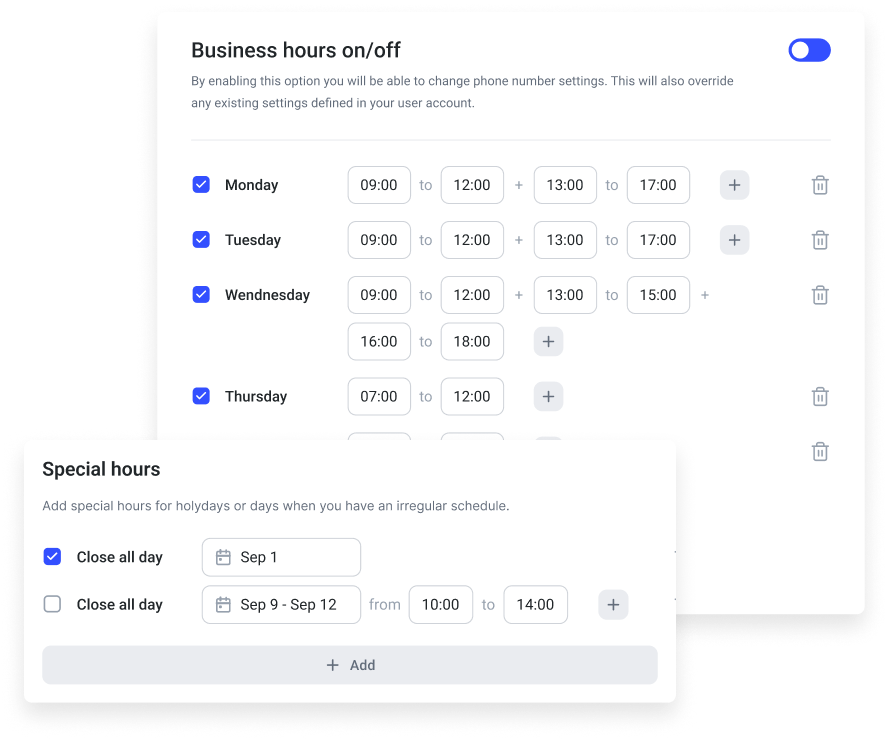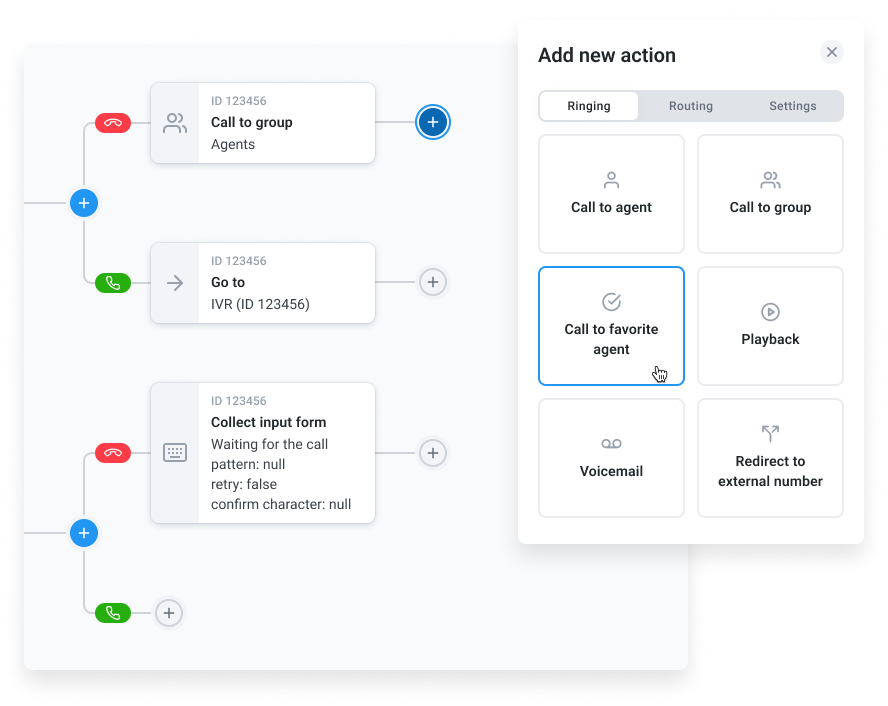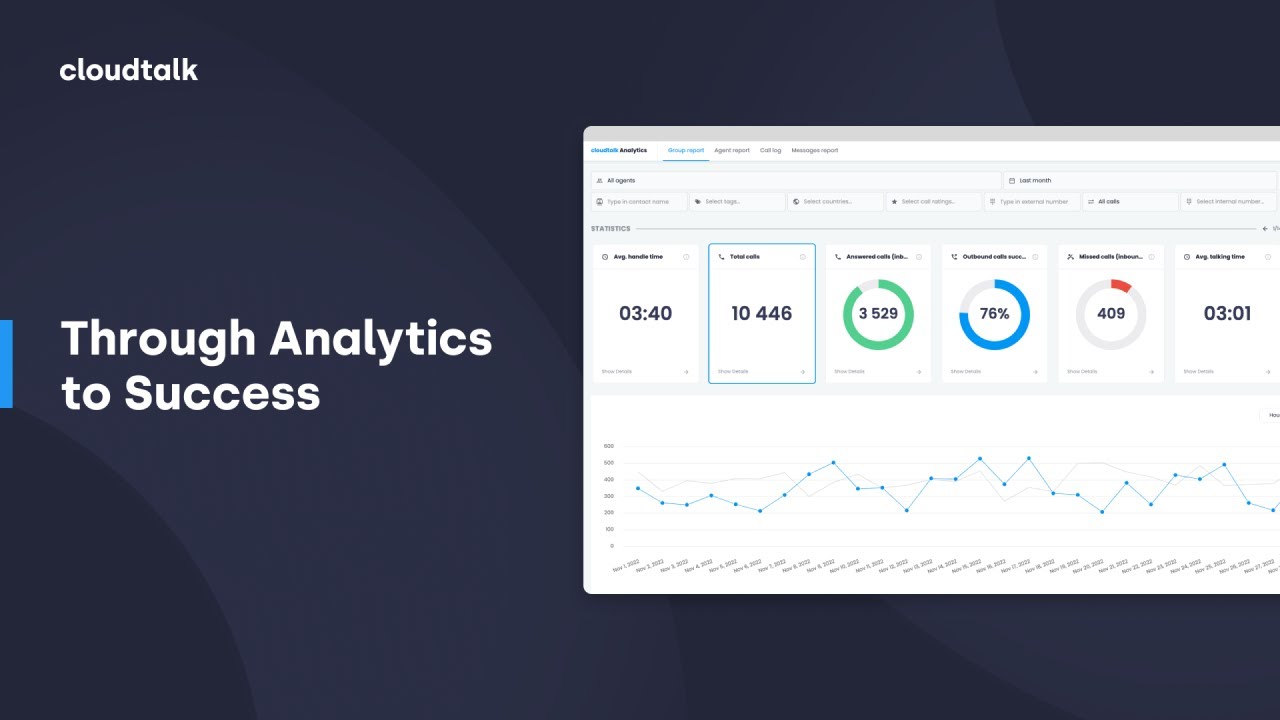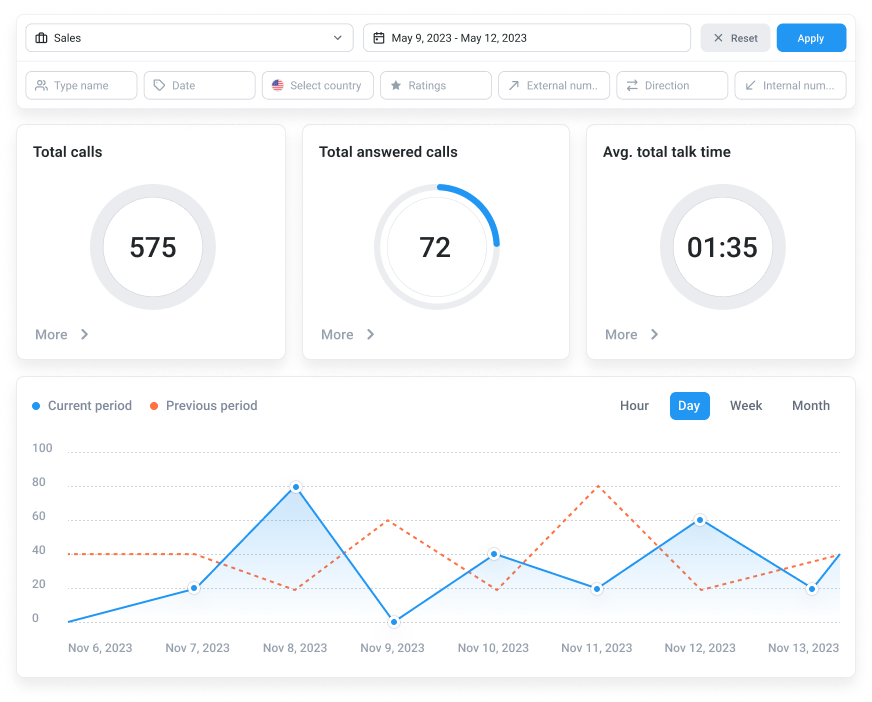Call centers thrive on high volume—as long as they see it coming.
But when calls spike out of nowhere, even the best teams scramble. One viral post, system glitch, or billing error can flood your lines in minutes—and put your CX at risk.
It’s no surprise that 75% of customers say it takes too long to reach a live agent¹. Call spikes only make that worse.
For operations leaders, support managers, and IT decision-makers in fast-moving industries like eCommerce, healthcare, or insurance, these moments aren’t rare. And when every second of response time shapes your brand’s reputation, there’s no margin for guesswork. You have to be ready.
That’s why in this guide, we’ll explore what really triggers call center call spikes, how they impact performance, and the 10 proven strategies that top-performing teams use to turn chaos into consistency.
Key takeaways:
-
Teams in high-pressure industries like eCommerce, healthcare, or finance must prepare for sudden spikes in call center volume to avoid churn and chaos.
-
Call spikes often stem from outages, promos, or errors—and flood your support lines due to high call volume in minutes.
-
Without the right tools, managing high call volume leads to long waits, dropped calls, and frustrated agents and customers.
-
The real damage happens during peak hours or unexpected surges—when your call center volume exceeds capacity.
-
CloudTalk helps you handle and prepare for call spikes with AI Voice Agents, callbacks, and flexible routing that keep your support scalable at any volume.
Stop letting call spikes decide your CX—see how CloudTalk helps you stay ahead.
What Are Call Center Call Spikes?
Call spikes are short bursts of unusually high inbound call volume. They overwhelm your available agents and exceed normal handling capacity—often leading to longer wait times, higher abandonment rates, and missed SLAs.
Some spikes are easy to predict. Others happen without warning. But the impact is always similar: systems slow down, queues grow, agents get swamped, and service quality takes a hit.
One of the biggest casualties during a spike is first call resolution (FCR). When agents are under pressure, they’re more likely to transfer calls, rush through issues, or miss key details—causing customers to call back multiple times for the same problem. That adds even more pressure to an already stretched system.
Even if your team is fully staffed for day-to-day operations, a single unplanned surge can unravel your CX efforts, push down FCR rates, and leave both agents and customers frustrated. That’s why smarter, more scalable systems are essential.
The good news? Call spikes don’t have to mean chaos. CloudTalk is your best call center solution to handle high call volumes—keeping FCR strong, abandonment low, and customers satisfied even at peak demand.
Just ask LKN Strategies, a healthcare consulting firm that transformed its operations after switching to CloudTalk.
Keep FCR High—Even During Call Spikes
When Might You Experience a Call Center Call Spike?
Not all spikes catch you off guard. Some are cyclical (seasonal), even expected—others come out of nowhere. The more patterns you can anticipate, the more you can prepare your call center to manage heavy call volume proactively.
1. Seasonal Call Spikes (Expected)
Expected call volume spikes result from known events that consistently and repeatedly drive up demand:
-
Holiday promotions and Black Friday: Customer activity spikes around sales—leading to a flood of pre-sale questions and post-purchase support.
-
Tax season or open enrollment: This is the time when support volumes rise mainly in finance, insurance, and healthcare sectors.
-
Subscription renewals: Customers call about renewals, cancellations, and unexpected charges.
-
Product launches: Release day often comes with troubleshooting, feature clarifications, or delivery issues, meaning tickets and calls spike up rapidly.
2. Unexpected Call Spikes
Sudden call center call spikes are harder to plan for and often require fast, automated mitigation:
-
Outages or technical issues: A server crash or app failure can trigger a huge increase in customer support calls within minutes.
-
Viral moments or PR events: A tweet goes viral, a TikTok trend takes off—your support lines light up fast.
-
Weather emergencies or disasters: Regional events create urgent safety or logistics-related calls.
-
Negative press or social backlash: Bad news can spike volume almost instantly.
-
Billing errors or data issues: Customers react quickly when financial or personal data is affected.
Why this matters: Categorizing spikes as expected or unexpected helps you prioritize the right mix of automation, routing, and staffing tools. It’s the first step to building resilience into your contact center strategy.
Pro Tip:
How Do Call Spikes Impact Call Centers and Businesses?
Call center call volume spikes don’t just create short-term headaches. They slow down systems, overwhelm agents, and increase the risk of missed calls or poor resolutions. If they’re not managed, these moments can quickly hurt customer trust and damage your brand’s reputation.
Here’s what’s at risk if your systems aren’t ready to handle high call volume:
-
Long wait times and dropped calls: Overwhelmed queues lead to missed calls and unhappy customers.
-
Lost sales or revenue: Each missed call is a missed opportunity—especially in sales-focused environments.
-
Lower CSAT and NPS: Customer Satisfaction (CSAT) and Net Promoter Score (NPS) drop sharply when service quality slips under pressure.
-
Burned-out agents: Your team pays the price when they’re stuck with nonstop calls and no relief, leading to higher turnover.
-
SLA breaches: Service Level Agreements (SLAs) define the standards you’ve promised customers or regulators. Long delays or unanswered calls risk contractual and compliance violations.
-
Damaged brand trust: Mishandling spikes can create lasting perception problems—especially if the frustration spreads on social media.
-
Customer churn: Once customers experience repeated delays or failed resolutions, they’re more likely to churn or simply switch to a competitor.
-
Inefficient staffing costs: Without the right systems, managers often resort to emergency overtime or overstaffing, leading to agent burnout or driving up costs without fixing the root problem.
This shows that managing call spikes isn’t as much about hiring more people, it is about choosing the right systems.
You need a scalable call center infrastructure that can absorb, deflect, and reroute call volume in real time, without degrading service.
So, let’s check out how CloudTalk’s AI-powered features can help you handle both seasonal and unexpected call spikes.
Pro Tip:
Be Ready for Every Call Spike
10 Proven Strategies to Handle Call Spikes With CloudTalk
Let’s get tactical…and practical. We put together 10 feature-backed strategies built to help your team handle call spikes and stay calm under pressure—no matter what caused the surge.
All of these solutions are available within the CloudTalk platform, either by default or through features included in advanced plans. You can deploy them individually or layer each into a scalable system for managing high call volume.
Before we dive into the details, here’s a quick overview of the core features that power your ability to absorb, reroute, or reduce call spikes:
-
01
CloudTalk Platform
-
02
AI Voice Agents
-
03
Virtual Receptionist
-
04
Callback Request
-
05
Business Hours Routing
-
06
Call Flow Designer
-
07
Smart Call Routing
-
08
Voicemail with Smart Alerts
-
09
Call Analytics & Real-Time Dashboards
-
10
IVR Menus
Let’s break down each feature & strategy and see exactly how it helps you prepare for or fight back against heavy call surges.
1. The Right Call Center Platform
No amount of tactics can save you if your foundation can’t flex. You need a platform that scales instantly, routes intelligently, and doesn’t collapse when traffic spikes.
Problem: Legacy (traditional) systems and on-premise setups struggle to adapt in real time.
Solution: CloudTalk’s cloud-native infrastructure handles unlimited concurrent calls and gives you full control over routing paths, agent availability, and overflow logic.
What to do:
-
Choose the Essential or Expert plan to unlock unlimited concurrent calls
-
Enable remote agents using browser-based softphones or the CloudTalk Go app
-
Use the Call Flow Designer to build flexible routing logic
This ensures your system can handle call spikes without bottlenecks—so you never have to turn customers away just because volume went up.
2. AI Voice Agent
The best way to reduce load? Prevent unnecessary live calls altogether.
Problem: Human agents can’t scale instantly or handle repetitive queries efficiently.
Solution: CloudTalk’s AI Voice Agent uses natural language processing to handle Tier 0–1 (fully self-serveed or basic customer support) calls automatically. Unlike most other call centers, CloudTalk offers AI Voice Agents that work across both inbound and outbound—so whether you’re triaging incoming volume or getting ahead of a surge, it helps you stay one step ahead.
Use CloudTalk’s Voice AI to:
-
Automate high-frequency requests like order tracking, booking confirmations, or password resets
-
Proactively send outbound reminders, updates, or follow-ups to reduce inbound pressure
-
Triage inbound calls by collecting info (intent, urgency, or ID) before routing
-
Handle availability checks, FAQs, or status queries without involving a live agent
-
Escalate only the calls that need a human touch—based on issue type, sentiment, or complexity
Voice agents are especially useful during promotions, product launches, or seasonal peaks when repetitive queries pile up fast. For outbound use, they let you generate & qualify leads, or reach hundreds of existing customers in minutes—with zero queue buildup on your end.
And yes, they sound surprisingly human—see (or hear) for yourself in the short video below.
If you’re operating in e-commerce, logistics, healthcare, or fintech—where common questions repeat thousands of times—this tool pays for itself in saved agent hours alone.
Want to hear it in action? Play a demo of how a voice agent handles various use cases from start to finish.

AI Voice Agents
Sales Reminder
Agent
Client
Sales / Marketing
Course Inquiry
Agent
Client
Education / EdTech
Payment Reminder
Agent
Client
Financial Services
Healthcare Intake
Agent
Client
Healthcare
Insurance Intake
Agent
Client
Insurance
T&C Acceptance
Agent
Client
Legal Services
Legal Intake
Agent
Client
Legal Services
Candidate Feedback
Agent
Client
Recruitment / HR
Applicant Pre-screen
Agent
Client
Recruitment / HR
Action Reminder
Agent
Client
SaaS / Software & Apps
Subscription Renewal
Agent
Client
SaaS / Software & Apps
CX Feedback
Agent
Client
SaaS / Software & Apps
Post-Sales Feedback
Agent
Client
SaaS / Software & Apps
Trial Signup
Qualifier
Client
SaaS / Software & Apps
3. Virtual Receptionist
Sometimes you don’t need full automation—just better intake.
Problem: Agents waste time handling calls that could be self-served or routed faster.
Solution: CloudTalk’s AI Virtual Receptionist is a conversational call answering solution powered by smart routing and voice input. It greets callers, captures their intent using natural language or keypad input, and sends them exactly where they need to go—without involving a live agent.
Set it up to:
-
Greet callers with a branded message or question
-
Collect input via speech or keypad (e.g., “I need billing” or “Press 2”)
-
Route to the right queue, department, or next step
-
Offer quick answers to FAQs like business hours, returns, or service status
Mind that this isn’t just your traditional IVR—it’s a lightweight, AI-backed 24/7 front-desk designed for high-volume, low-complexity calls. It shines after hours, during holidays, or whenever your lines get flooded with simple requests.
When your call volume spikes, this is the layer that shields your agents from answering calls that should never reach them in the first place.
4. Callback Request
Let customers skip the wait—but not the support.
Problem: Long queues cause drop-offs and frustration.
Solution: CloudTalk’s Callback feature captures the customer’s info and places them in a virtual queue. Your system calls them back automatically when an agent becomes available.
How to use it:
-
Enable the callback option in your IVR menu so callers can press a key to request a call back instead of waiting on hold
-
Set callback priority rules, for example, move VIP customers or urgent issues to the top of the queue
-
Automate retries so the system calls back again if the customer misses the first attempt
The result? You shift high call volume across time instead of letting it overwhelm your team in the moment.
If you don’t offer callbacks during spikes, you’re making customers wait when they don’t have to—and risking losing them for good.
5. Business Hours Routing
Not every call spike happens during the day—and your business hours routing strategy should reflect that.
Problem: After-hours calls pile up without intelligent fallback options.
Solution: Use CloudTalk’s Business Hours feature to define when your team is available, and automatically reroute calls outside those hours.
What it does:
-
Diverts calls during off-hours to voicemail, AI Voice Agent, or a callback request
-
Customizes routing rules by phone number, queue, or region
-
Ensures every call has a next step—even when no one is online to take it
You can configure business hours directly in CloudTalk’s settings for each line, department, or country-specific support team. Just check out how simple it is in the picture below.
6. Call Flow Designer
Static routing collapses when call patterns change. You need flexibility.
Problem: Fixed call paths can’t adapt to live conditions.
Solution: CloudTalk’s drag-and-drop Call Flow Designer lets you create dynamic routing flows based on availability, skills, or caller type—so you can adapt in real time without writing a single line of code.
Use it to:
-
Set up overflow rules—route to AI or voicemail when queues spike
-
Isolate VIPs or escalations into dedicated flows
-
Switch logic instantly as volume patterns shift
Think of it as your control panel for call chaos. If you’re not using it, you’re reacting to spikes instead of staying ahead of them.
So why not use it?
Especially when it’s so easy to design your own call flows with CloudTalk, just like you can see in the image below.
One company that saw major improvements from building smarter call flows is Bit2Me—a crypto platform that dramatically cut wait times and missed calls by rethinking how they routed support.
7. Call Routing
Not all callers should be treated the same. Prioritization helps reduce pressure fast.
Problem: Random routing wastes agent time and frustrates customers.
Solution: CloudTalk offers conditional Call Routing that sends calls to the right places based on skill, priority, or agent availability—not first-come, first-served.
Need an example? Just check what skill-based routing looks like in the picture below.
Examples:
-
Send VIPs to senior agents automatically
-
Route by language, location, or past issue
-
Use fallback paths when queues are full
Routing is the difference between quick resolutions and bottlenecks. It’s the lever that ensures the right agents get the right calls, even during a spike.
8. Voicemail with Smart Alerts
If you can’t answer every call live, make sure none go unnoticed.
Problem: Missed calls = missed revenue or unresolved issues.
Solution: CloudTalk logs Voicemails with timestamps, caller ID, and optional call transcription, then alerts your team immediately.
Set up workflows to:
-
Route voicemails by department
-
Auto-tag for follow-up urgency
-
Trigger callbacks or email follow-ups
Voicemail isn’t a fallback but rather a strategic safety net. And when handled right, it ensures nothing slips through the cracks.
Just don’t confuse them with Personalized Messages—those are what you play to callers before the system connects them with you. Voicemails are what they leave behind when you miss the call.
Need Voicemail Inspiration?
9. Call Analytics & Real-Time Dashboards
Volume spikes may feel random—but data often tells a different story.
Problem: Without trends, you can’t predict or prepare.
Solution: CloudTalk’s Call Analytics and Real-Time Dashboards show you exactly when, where, and why spikes occur—giving you the visibility you need to plan ahead or act fast in the moment.
Here’s what that looks like in action—CloudTalk’s live dashboards give you real-time visibility into total calls, queue length, agent availability, and wait times, all in one view.
Use analytics & dashboard insights to:
-
Forecast future surges based on historical call volume trends
-
Adjust staffing proactively before your lines start to overflow
-
Refine routing and call flows for your busiest hours and bottleneck times
-
Monitor performance live with dashboards showing missed calls, wait times, and agent availability
Spikes aren’t always preventable—but they’re rarely unpredictable if you’re watching the right metrics.
10. IVR Menus
Every smart call flow starts with a solid IVR setup.
Problem: Without guided call intake, your agents waste time redirecting calls—or worse, your customers give up in frustration.
Solution: CloudTalk’s Interactive Voice Response (IVR) system helps you guide callers to the right place based on input—before a human ever needs to step in. It’s simple to build, easy to update, and critical when call volume spikes.
Use it to:
-
Let callers route themselves by pressing a number or speaking their intent
-
Trigger different flows based on caller input (e.g., language, department, urgency)
-
Collect info like order numbers or account IDs before passing the call to an agent
IVR is often the first impression your customers get—so it needs to be fast, clear, and effective.
With CloudTalk, you can build the best multi-level IVRs inside the Call Flow Designer, customize per region or number, and easily connect it to features like callback, virtual receptionist, or your AI Voice Agent.
And while the setup process might sound complex, CloudTalk’s drag-and-drop designer makes building custom IVR paths very intuitive. Just see for yourself in the picture below.
Pro Tip:
Ready to Handle Your Next Call Spike Like a Pro?
When call spikes hit, speed and clarity win.
CloudTalk gives you both—through AI Voice Agents that deflect repetitive calls, callback systems that prevent queue overflow, and routing tools that send every call to the right place.
It’s how companies like Bit2Me slashed missed calls by 80%, and how LKN Strategies boosted first call resolution by 20% while cutting abandonment by 40%—even during heavy volume.
So, whether your spikes are seasonal or unexpected, be sure that CloudTalk is the best call center solution to handle calls at scale—anywhere, anytime, across any team setup. You stay prepared, your agents stay focused, and your customers stay satisfied.
Learn how to handle call spikes like a pro—before they cost you customers.
Sources:







































